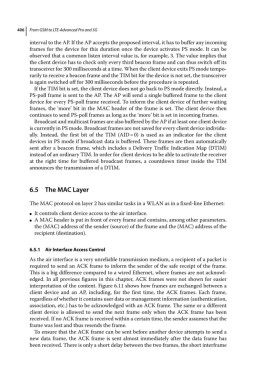Page 420 - From GMS to LTE
P. 420
406 From GSM to LTE-Advanced Pro and 5G
interval to the AP. If the AP accepts the proposed interval, it has to buffer any incoming
frames for the device for this duration once the device activates PS mode. It can be
observed that a common listen interval value is, for example, 3. The value implies that
the client device has to check only every third beacon frame and can thus switch off its
transceiver for 300 milliseconds at a time. When the client device exits PS mode tempo-
rarily to receive a beacon frame and the TIM bit for the device is not set, the transceiver
is again switched off for 300 milliseconds before the procedure is repeated.
If the TIM bit is set, the client device does not go back to PS mode directly. Instead, a
PS‐poll frame is sent to the AP. The AP will send a single buffered frame to the client
device for every PS‐poll frame received. To inform the client device of further waiting
frames, the ‘more’ bit in the MAC header of the frame is set. The client device then
continues to send PS‐poll frames as long as the ‘more’ bit is set in incoming frames.
Broadcast and multicast frames are also buffered by the AP if at least one client device
is currently in PS mode. Broadcast frames are not saved for every client device individu-
ally. Instead, the first bit of the TIM (AID = 0) is used as an indicator for the client
devices in PS mode if broadcast data is buffered. These frames are then automatically
sent after a beacon frame, which includes a Delivery Traffic Indication Map (DTIM)
instead of an ordinary TIM. In order for client devices to be able to activate the receiver
at the right time for buffered broadcast frames, a countdown timer inside the TIM
announces the transmission of a DTIM.
6.5 The MAC Layer
The MAC protocol on layer 2 has similar tasks in a WLAN as in a fixed‐line Ethernet:
It controls client device access to the air interface.
●
A MAC header is put in front of every frame and contains, among other parameters,
●
the (MAC) address of the sender (source) of the frame and the (MAC) address of the
recipient (destination).
6.5.1 Air Interface Access Control
As the air interface is a very unreliable transmission medium, a recipient of a packet is
required to send an ACK frame to inform the sender of the safe receipt of the frame.
This is a big difference compared to a wired Ethernet, where frames are not acknowl-
edged. In all previous figures in this chapter, ACK frames were not shown for easier
interpretation of the content. Figure 6.11 shows how frames are exchanged between a
client device and an AP, including, for the first time, the ACK frames. Each frame,
regardless of whether it contains user data or management information (authentication,
association, etc.) has to be acknowledged with an ACK frame. The same or a different
client device is allowed to send the next frame only when the ACK frame has been
received. If no ACK frame is received within a certain time, the sender assumes that the
frame was lost and thus resends the frame.
To ensure that the ACK frame can be sent before another device attempts to send a
new data frame, the ACK frame is sent almost immediately after the data frame has
been received. There is only a short delay between the two frames, the short interframe

